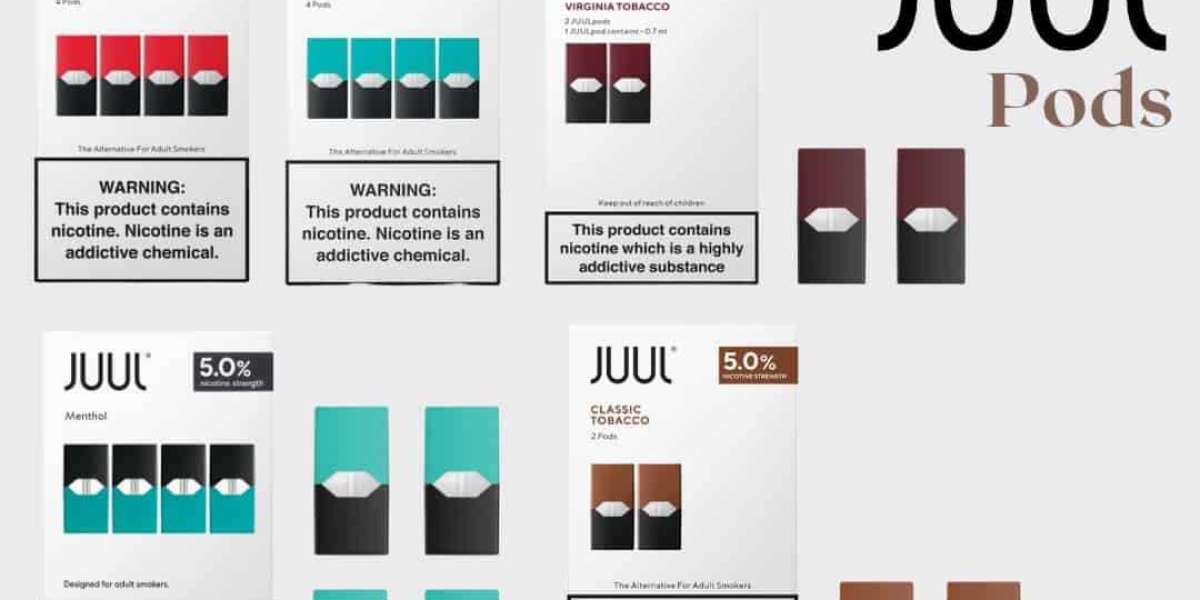In recent years, vaping has become an alternative to traditional smoking, offering users a less harmful method of nicotine consumption. Among the various vaping devices available, JUUL has emerged as one of the most popular. Known for its sleek design, ease of use, and a variety of flavored pods, JUUL has taken the vaping world by storm. But what exactly makes JUUL pods so popular, and why have they become a focal point in the discussion surrounding vaping? This comprehensive guide aims to cover everything about JUUL pods, from their ingredients and design to the controversies and regulations surrounding them.
1. Introduction to JUUL Pods
JUUL pods are small, pre-filled cartridges that contain nicotine salts derived from tobacco leaves, along with other ingredients that provide flavor and vapor when heated. These pods are designed for use with the JUUL device, a compact and user-friendly e-cigarette. What sets JUUL apart from many other e-cigarette brands is its simplicity. Unlike traditional cigarettes, which require lighting and burning, or even some other vape devices that require manual refilling of e-liquid, JUUL pods are plug-and-play. Users simply insert a pod into the device and start vaping.
2. Ingredients in JUUL Pods
The main ingredients in JUUL pods are as follows:
Nicotine Salts: The most crucial ingredient is nicotine, but not just any nicotine—JUUL pods contain nicotine salts, which are derived from tobacco leaves. Nicotine salts allow for faster absorption into the bloodstream, providing a more satisfying experience that mimics the sensation of smoking traditional cigarettes.
Propylene Glycol (PG): This is a common ingredient in e-liquids and is responsible for carrying flavor and producing vapor. It also contributes to the throat hit sensation that many vapers seek.
Vegetable Glycerin (VG): Another key ingredient, VG adds thickness to the vapor and gives a smoother inhaling experience. The combination of VG and PG creates the balance between vapor production and flavor.
Benzoic Acid: This is added to JUUL pods to help stabilize the nicotine salts and lower the pH level, making the nicotine smoother to inhale.
Flavorings: JUUL pods are available in a variety of flavors, including tobacco, menthol, and fruit flavors. The flavoring ingredients are food-grade and are designed to provide a pleasant vaping experience.
3. Variety of Flavors
JUUL pods originally gained much of their popularity because of the wide variety of flavors that appealed to smokers looking to transition from cigarettes. Popular flavors have included:
Classic Tobacco: A smooth, robust tobacco flavor, meant to closely mimic the taste of traditional cigarettes.
Mint and Menthol: Cool and refreshing flavors that provide a minty taste on the inhale and exhale.
Fruit Medley: A sweet and fruity blend that was popular among younger vapers.
Mango: A tropical flavor that became one of JUUL’s most iconic offerings.
Over time, however, due to regulatory pressure, some of these flavors have been discontinued in various markets. This is primarily because flavored pods were found to appeal to younger users, raising concerns about underage vaping.
4. Nicotine Levels in JUUL Pods
Each JUUL pod contains a high concentration of nicotine compared to other vaping products. Most JUUL pods in the U.S. market contain either 3% or 5% nicotine by weight, translating to about 23 to 59 mg/ml. This is significantly higher than many other e-cigarettes, which often offer lower nicotine concentrations. One JUUL pod is roughly equivalent to a pack of cigarettes in terms of nicotine content.
The high nicotine content is a double-edged sword. For adult smokers looking to quit traditional cigarettes, JUUL’s nicotine strength can satisfy cravings more effectively than weaker alternatives. However, this has also led to concerns about addiction, particularly among young and inexperienced users.
5. The Appeal of JUUL Pods
Several factors contribute to the broad appeal of JUUL pods:
Discreet Design: The JUUL device is small and sleek, resembling a USB flash drive, making it easy to carry around and use discreetly. The pods themselves are small and lightweight, adding to the overall portability of the system.
Ease of Use: Unlike many other vaping devices that require refilling or coil replacements, JUUL pods come pre-filled, making them incredibly easy to use. Users simply insert a pod into the device and begin vaping immediately.
Satisfaction: Thanks to the use of nicotine salts, JUUL pods deliver nicotine quickly and efficiently. This fast absorption provides immediate relief from nicotine cravings, making the transition from smoking to vaping smoother for many users.
Flavor Variety: Although some flavors have been discontinued due to regulatory concerns, JUUL initially gained a large following because of the wide variety of flavors offered. The ability to switch between different flavor profiles is a big draw for many vapers.
6. Controversies and Health Concerns
Despite its popularity, JUUL has faced significant criticism and controversy. One of the main concerns revolves around the high nicotine content in JUUL pods and its potential for addiction, especially among teenagers. Studies have shown that a significant number of high school students have tried vaping, and JUUL, with its discreet design and flavorful pods, has often been singled out as a contributing factor.
In response to growing public concern, the FDA and other regulatory bodies have implemented stricter rules on the sale of flavored vaping products. In many places, fruity and sweet flavors have been banned, and JUUL has stopped selling these flavors in the U.S. market to curb underage use.
There are also ongoing debates about the long-term health effects of vaping. While many experts agree that vaping is likely less harmful than smoking traditional cigarettes due to the lack of combustion, the full extent of the health risks remains unknown. Concerns about lung injury, nicotine addiction, and other potential health problems have led to calls for further research and regulation.
7. Regulatory Actions
The vaping industry, including JUUL, is subject to increasing regulatory scrutiny. Many countries have implemented age restrictions, requiring users to be 18 or 21 years old to purchase vaping products. In the U.S., the Food and Drug Administration (FDA) has taken steps to regulate the sale and marketing of JUUL pods, especially targeting their appeal to minors.
Countries like India and Brazil have banned e-cigarettes altogether, citing public health concerns, while other nations have imposed strict regulations on the sale of flavored pods. In the European Union, for instance, the nicotine content in e-liquids is capped at 20 mg/ml, which is significantly lower than JUUL’s standard nicotine concentrations in the U.S.
8. Future of JUUL and Vaping
As the vaping industry continues to evolve, the future of JUUL and other similar products will likely depend on regulatory actions, scientific research, and consumer demand. JUUL has already made adjustments in response to criticism, such as discontinuing certain flavors and implementing stricter age verification measures for online sales.
In the future, we may see further innovations in vaping technology, including devices that allow for greater control over nicotine intake or that offer more health-conscious alternatives. At the same time, ongoing studies into the long-term effects of vaping will likely influence future regulations.
Our tops blogs and Products:
- buy juul pods
- myle pods flavors
- stig purple bomb
- VELO Dubai
- al fakher
- ghost pro
- mighty mint vape
- silver heets
- vnsn 12000
- juul mango pods
- meta 9000
- pod salt nexus 6000
- ghost pro elite 7000 puffs
- myle lush ice
- tugboat evo 4500
- tugboat 12000 puffs
- vnsn 12000 puffs
- Pod salt 2500
- vgod stig pods
9. Conclusion
JUUL pods have had a profound impact on the vaping industry, offering smokers a convenient, portable, and satisfying alternative to traditional cigarettes. Their high nicotine content, ease of use, and variety of flavors made them a popular choice, but also brought about significant controversy, particularly concerning youth addiction and regulatory challenges.
As the industry moves forward, consumers and regulators alike will need to weigh the benefits of vaping as a smoking cessation tool against the potential risks, particularly among younger users. For adult smokers, JUUL pods may continue to be a useful tool in the journey to quit traditional cigarettes, but ongoing developments will likely shape the future of this popular vaping product.








